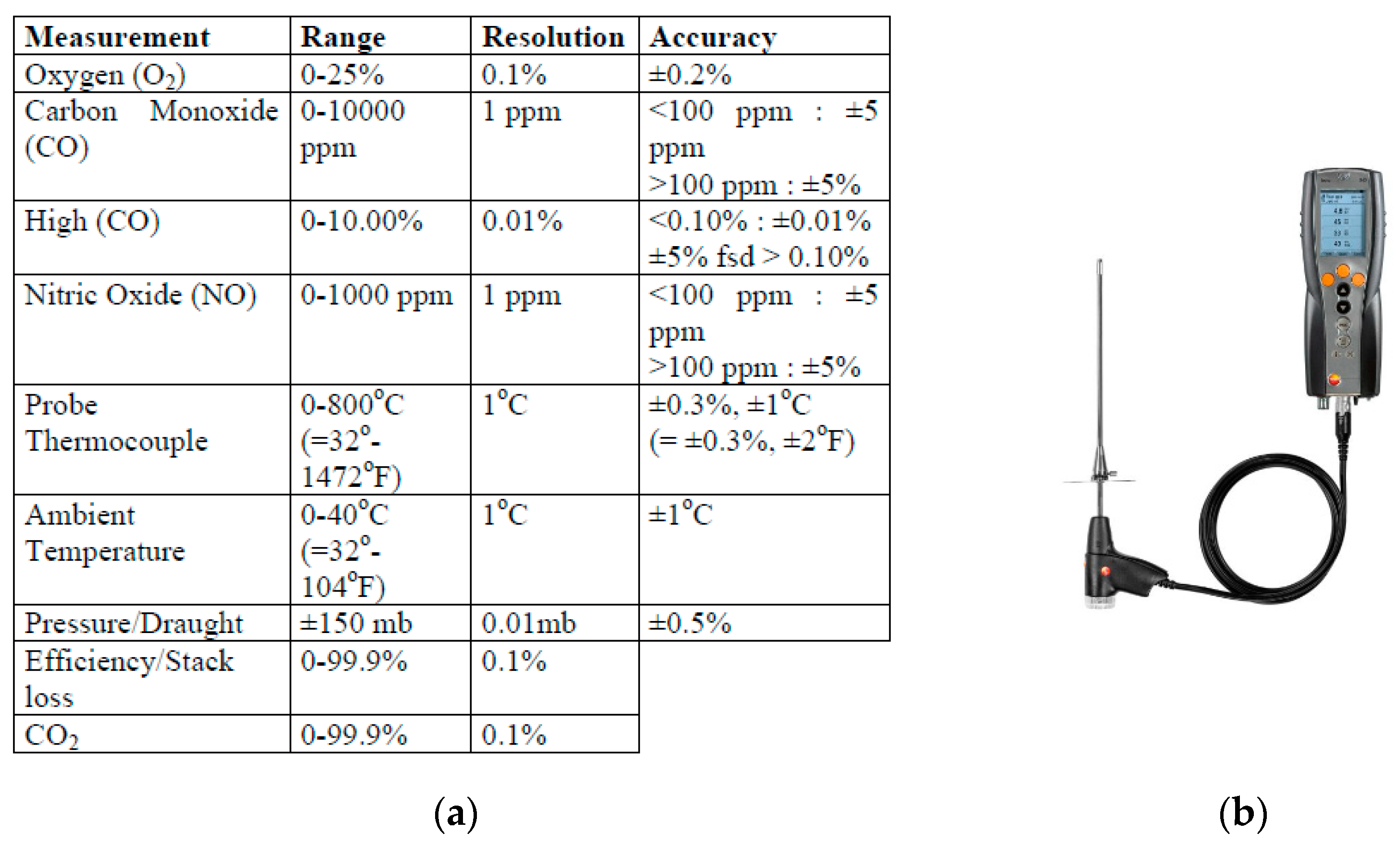Combustion of Emulsions in Internal Combustion Engines and Reduction of Pollutant Emissions in Isolated Electricity Systems
Abstract
1. Introduction
1.1. Water Emulsion Technology in Fuel Oil
- -
- Micro explosion
- -
- Cooling
- -
- Increased fuel spray momentum
- -
- Water-Gas reaction
1.2. Determination of the Diameter of the Water Droplets Incorporated into the Fuel
2. Materials and Methods
2.1. Case Study
- The reduction of specific fuel consumption.
- The reduction of CO, NOx emissions and soot into the atmosphere.
- The optimization of process efficiency.
2.1.1. Characterization of the Fuel Load
2.1.2. Water Characterization
2.1.3. Internal Combustion Engines
- cylinder diameter 400 mm,
- stroke: 560 mm,
- speed 500 RPM,
- fuel: heavy fuel oil (HFO) and diesel,
- power output: 660 and 720 kW/cyl,
- 16 cylinders and 6 engines,
- 50 Hz.
2.1.4. S System
- The reduction of NOx emissions and particles (1% v/v water is equivalent to 1% NOx reduction, with reductions up to 20% NOx in 4-stroke diesel engines).
- Improved combustion quality without increasing fuel consumption.
- The reduction of carbon waste deposition in turbos, pistons, cylinders and valves.
- The reduction/elimination of asphaltenes after fuel treatment.
2.1.5. P system
2.1.6. N System
2.2. Research Methods
- Design of the reference case at different engine operation systems: 7.5 MW, 8.5 MW, 9.5 MW, 500 rpm, fuel oil.
- The addition of water until process model I: 8.5 MW emulsion with 15% v/v water.
- 3.
- The addition of water until process model II: 8.5 MW emulsion with 18% v/v water.
- 4.
- Run the test program and adjustment of process parameters.
- 5.
- Monitoring and controlling all the parameters selected.
3. Results and Discussion
3.1. Comparative Analysis of Systems S, P, N
3.2. Process Model I: Addition of 15% v/v Water
3.3. Process Model II: Addition of 18% v/v Water
3.4. Laboratory Analysis of Emulsion Samples
3.5. Performance Indicators
4. Conclusions
Author Contributions
Funding
Data Availability Statement
Acknowledgments
Conflicts of Interest
References
- United Nations Framework Convention on Climate Change, Conference of Parties, Adoption of the Paris Agreement, Twenty-First session, Paris, 30 November to 11 December 2015. Available online: https://www.natureaustralia.org.au/what-we-do/our-priorities/climate-change/climate-change-stories/take-climate-action-cop26/?gclid=Cj0KCQjw--2aBhD5ARIsALiRlwAWgHuntdpngsdK38XBzhmbDp4-1CIxXSSJY1cSn25OLIPSJZrDGW4aAm0fEALw_wcB (accessed on 19 May 2022).
- Baskar, P.; Kumar, A.S. Experimental investigation on performance characteristics of a diesel engine using diesel-water emulsion with oxygen enriched air. Alex. Eng. J. 2017, 56, 137–146. [Google Scholar] [CrossRef]
- Hasannuddin, A.K.; Wira, J.Y.; Sarah, S.; Ahmad, M.I.; Aizam, S.A.; Aiman, M.A.B.; Watanabe, S.; Hirofumi, N.; Azrin, M.A. Durability studies of single cylinder diesel engine running on emulsion fuel. Energy 2016, 94, 557–568. [Google Scholar] [CrossRef]
- Qian, X.; Lee, S.; Chandrasekaran, R.; Yang, Y.; Caballes, M.; Alamu, O.; Chen, G. Electricity Evaluation and Emission Characteristics of Poultry Litter Co-Combustion Process. Appl. Sci. 2019, 9, 4116. [Google Scholar] [CrossRef]
- Lin, C.Y.; Chen, L.W. Engine performance and emission characteristics of three-phase diesel emulsions prepared by an ultrasonic emulsification method. Fuel 2006, 85, 593–600. [Google Scholar] [CrossRef]
- Badran, O.; Emeish, S.; Abu-Zaid, M.; Abu-Rahma, T.; Al-Hasan, M.; Al-Ragheb, M. Impact of emulsified Water/Diesel Mixture on Engine Perfomance and Environment. Int. J. Therm. Environ. Eng. 2011, 3, 1–7. [Google Scholar] [CrossRef]
- Nadeem, M.; Rangkuti, C.; Anuar, K.; Haq, M.R.U.; Tan, I.B.; Shah, S.S. Diesel engine performance and emission evaluation using emulsified fuels stabilized by conventional and gemini surfactants. Fuel 2006, 85, 2111–2119. [Google Scholar] [CrossRef]
- Yang, W.M.; An, H.; Chou, S.K.; Vedharaji, S.; Vallinagam, R.; Balaji, M.; Mohammad, F.E.A.; Chua, K.J.E. Emulsion fuel with novel nano-organic additives for diesel engine application. Fuel 2013, 104, 726–731. [Google Scholar] [CrossRef]
- Cook, D.H.; Law, C.K. A preliminary study on the utilization of water-in oil emulsions in diesel engines. Combust. Sci. Technol. 1978, 18, 217–221. [Google Scholar] [CrossRef]
- Alan Canfield, C. Effects of Diesel-Water Emulsion Combustion on Diesel Engine NOx Emission. Master’s Thesis, University of Florida, Gainesville, FL, USA, 1999. [Google Scholar]
- Eaton, S.J.; Wallace, T.T.; Sarnacki, B.G.; Adams, T.L.; Kimball, R.W.; Henry, J.A.; Harakas, G.N. Combustion and emissions of a glycerol-biodiesel emulsion fuel in a medium-speed engine. J. Mar. Eng. Technol. 2019, 18, 102–111. [Google Scholar] [CrossRef]
- Selim, M. Ghannam, Combustion Study of Stabilized Water-in-Diesel Fuel Emulsion. Energy Sources Part A Recovery Util. Environ. Eff. 2009, 32, 256–274. [Google Scholar] [CrossRef]
- Attia, A.M.; Nour, M.; El-Seesy, A.I.; Nada, S.A. The effect of castor oil methyl ester blending ratio on the environmental and the combustion characteristics of diesel engine under standard testing conditions. Sustain. Energy Technol. Assess. 2020, 42, 100843. [Google Scholar] [CrossRef]
- Heywood, J.B. International Combustion Engine Fundamentals, McGraw-Hill, New York, Johnson. T., 2016, Vehicular emissions in review. SAE Int. J. Engines 1988, 9, 1258–1275. [Google Scholar]
- Maji, D.; Mondal, P.K.; Mandal, B.K. Experimental investigation on the use of water emulsified diesel in a single cylinder compression ignition engine. IOP Conf. Ser. Mater. Sci. Eng. 2018, 377, 012123. [Google Scholar] [CrossRef]
- Mondal, P.K.; Mandal, B.K. A comprehensive review on the feasibility of using water emulsified diesel as CI engine fuel. Fuel 2019, 237, 937–960. [Google Scholar] [CrossRef]
- Topal, H.; Amirabedin, E. Determination of some important emissions of poultry waste co-combustion. Sci. J. Riga Tech. Univ. Environ. Clim. Technol. 2012, 8, 12–17. [Google Scholar] [CrossRef]
- Armesto, L.; Bahillo, A.; Veijonen, K.; Cabanillas, A.; Otero, J. Combustion behaviour of rice husk in a bubbling fluidised bed. Biomass Bioenerg. 2002, 23, 171–179. [Google Scholar] [CrossRef]
- Varol, M.; Atimtay, A.T.; Olgun, H.; Atakül, H. Emission characteristics of co-combustion of a low calorie and high sulfur–lignite coal and woodchips in a circulating fluidized bed combustor: Part 1. Effect of excess air ratio. Fuel 2014, 117, 792–800. [Google Scholar] [CrossRef]
- Jiang, L.; Agrawal, A.K. Combustion of straight glycerol with/without methane using a fuel-flexible, low-emissions burner. Fuel 2014, 136, 177–184. [Google Scholar] [CrossRef]
- Fu, W.; Gong, J.; Hou, L. There is no micro-explosion in the diesel engines fueled with emulsified fuel. Chin. Sci. Bull. 2006, 51, 1261–1265. [Google Scholar] [CrossRef]
- Ivanov, V.M.; Nevedov, P.I. Experimental Investigation of the Combustion Process of Natural and Emulsified Liquid Fuels; National Aeronautics and Space Administration, and the National Science Foundation: Washington, DC, USA, 1965. [Google Scholar]
- Lindstad, H.; Eskeland, G.; Psaraftis, H.; Sandaas, I.; Stromman, A. Maritime shipping and emissions: A three-layered, damage-based approach. Ocean Eng. 2015, 110, 94–101. [Google Scholar] [CrossRef]
- Ithnin, A.M.; Yahya, W.J.; Ahmad, M.A.; Ramlan, N.A.; Kadir, H.A.; Sidik NA, C.; Koga, T. Emulsifier-free water-in-diesel emulsion fuel, its stability, engine performance and exhaust emission. Fuel 2018, 215, 454–462. [Google Scholar] [CrossRef]
- Remigious, P.; Kandasamy, A.; Rajaram, P. An Experimental Investigation into Chosen Parameters of Diesel-Water Emulsion on Combustion Processes; Hindawi Publishing Corporation: London, UK, 2013; Volume 3. [Google Scholar]
- Warmburg, B.M. Sustainable Energy for Islands: Opportunities Versus Constraints of a 100% Renewable Electricity Systems. El hierro (Canary Islands) and Flores (Azores) Case Studies. Master’s Thesis, Lund University, Lund, Sweden, 2006. [Google Scholar]
- Cross-Call, D.F. Matching Energy Storage to Small Island Electricity Systems: A Case Study of the Azores. Master’s Thesis, Massachusetts Institute, Cambridge, UK, 2013. [Google Scholar]
- Magueijo, V.; Fernandes, M.; Matos, H.A.; Nunes, C.P.; Calau, J.P. Medidas de Eficiência Energética Aplicáveis à Indústria Portuguesa: Um Enquadramento Tecnológico Sucinto, Plano Nacional de Acção para a Eficiência Energética Grupo 5–Grupo de Trabalho Indústria, 24 September 2008, Portugal. Available online: https://www.expofig.com/noticias/9/medidas-de-eficiencia-energetica-aplicaveis-a-industria-de-iluminacao (accessed on 19 May 2022).
- Soares, J.O.; Fernandes, A.V.; Março, A.A.; Marques, J.P. Avaliação de Projectos de Investimento na Óptica Empresarial; Edições Sílabo: Lisboa, Portugal, 1999. [Google Scholar]
- Walas, S.M. Chemical Process Equipment Selection and Design; Butterworth Heinemann: Oxford, UK, 1990. [Google Scholar]
- Perry, J.H. Chemical Engineers’ Handbook/Prepared by a Staff of Specialists; McGraw-Hill: New York, NY, USA, 1950. [Google Scholar]
- Turton, R.; Bailie, R.C.; Whiting, W.B.; Shaeiwitz, J.A. Analysis, Synthesis and Design of Chemical Processes; Prentice Hall: Hoboken, NJ, USA, 1998. [Google Scholar]
- ASTM D975-20a; Standard Specification for Diesel Fuel Oils. ASTM International: West Conshohocken, PA, USA, 2020.
- Fu, Z.S.; Liu, M.; Xu, J.T.; Wang, Q.; Fan, Z.Q. Stabilization of water-inoctane nano-emulsion. Part I: Stabilized by mixed surfactant systems. Fuel 2010, 89, 2838–2843. [Google Scholar] [CrossRef]
- Vigneswaran, R.; Annamalai, K.; Dhinesh, B.; Krishnamoorthy, R. Experimental investigation of unmodified diesel engine performance, combustion and emission with multipurpose additive along with water-in-diesel emulsion fuel. Energy Convers. Manag. 2018, 172, 370–380. [Google Scholar] [CrossRef]
- Ishida, H.; Tachibana, K. A mechanical emulsification technology of petroleum fuels without surface active agent. Nagaoka Natl. Coll. Technol. 2009, 45, 47–54. [Google Scholar]
- Mondal, P.K.; Mandal, B.K. Water emulsified diesel, stability and physical property analysis and its feasibility as alternative fuel for diesel engine. Eng. Sci. Int. Res. J. 2016, 4, 122–126. [Google Scholar]
- Kim, H.; Kim, Y.; Lee, K. An experimental study on the spray, combustion, and emission characteristics of two types of biodiesel fuel. Energy Fuels 2013, 27, 5182–5191. [Google Scholar] [CrossRef]
- Kim, H.; Won, J.; Baek, S.W. Evaporation of a single emulsion fuel droplet in elevated temperature and pressure conditions. Fuel 2018, 226, 172–180. [Google Scholar] [CrossRef]
- Mondal, P.K.; Mandal, B.K. Experimental investigation on the combustion, performance and emission characteristics of a diesel engine using water emulsified diesel prepared by ultrasonication. J. Braz. Soc. Mech. Sci. Eng. 2018, 40, 510. [Google Scholar] [CrossRef]
- Mondal, P.K.; Mandal, B.K. Combustion and Performance Characteristics of a Diesel Engine using Emulsified Diesel Prepared by Ultrasonicator. In Proceedings of the 2017 International Conference on Advances in Mechanical, Industrial, Automation and Management Systems (AMIAMS), Allahabad, India, 3–5 February 2017. [Google Scholar] [CrossRef]
- Kojima, Y.; Imazu, H.; Nishida, K. Physical and chemical characteristics of ultrasonically-prepared water-in-diesel fuel, effects of ultrasonic horn position and water content. Ultrason, Sonochem. 2014, 21, 722–728. [Google Scholar] [CrossRef]
- Li, J.; Sanderson, R.D.; Jacobs, E.P. Ultrasonic cleaning of nylon microfiltration membranes fouled by kraft paper mill effluent. J. Membr. Sci. 2002, 205, 247–257. [Google Scholar] [CrossRef]
- Karim, Z.A.A.; Kaur, E.; Masharuddin, S.M.S.; Khan, M.Y.; Hagos, F.Y. The characteristics of water-in-biodiesel emulsions produced using ultrasonic homogenizer. Alex. Eng. J. 2020, 59, 227–237. [Google Scholar] [CrossRef]
- Leng, L.; Yuan, X.; Zeng, G.; Chen, X.; Wang, H.; Li, H.; Fu, L.; Xiao, Z.; Jiang, L.; Lai, C. Rhamnolipid based glycerol-in-diesel microemulsion fuel: Formation and characterization. Fuel 2015, 147, 76–81. [Google Scholar] [CrossRef]
- Kee, R.J.; Rupley, F.M.; Miller, J.A. CHEMKIN-II: A FORTRAN Chemical Kinetics Package for the Analysis of Gas Phase Chemical Kinetics; Sandia National Laboratories: Livermore, CA, USA, 1989. [Google Scholar]
- Jiang, H.; Xu, S.; Cai, X.; Weng, H. Comparisons of diesel micro-emulsion properties using spontaneous emulsifying and ultrasonic dispersing methods. Pet. Sci. Technol. 2014, 32, 1763–1770. [Google Scholar] [CrossRef]
- Uson, N.; Garcia, M.J.; Solans, C. Formation of water-in-oil (w/o) nanoemulsions in water/mixed non-ionic surfactant/oil systems prepared by a low-energy emulsification method. Colloids Surf. A 2004, 250, 415–421. [Google Scholar] [CrossRef]
- DNV Petroleum Services and Alfa Laval, Fuel Oil Quality and Fuel Oil Treatment, DNV. April 2014. Available online: https://maritimeexpert.files.wordpress.com/2016/08/manual-dnvps-alfalaval-fuel-oil-quality-treatment.pdf (accessed on 19 May 2022).
- U.S. Department of Energy Pumping Systems. Match Pumps to System Requirements. 2005. Available online: https://www.energy.gov/sites/prod/files/2014/05/f16/match_pumps_to_system.pdf (accessed on 19 May 2022).
- Sulzer. Test Bed Report in New Sulzer Diesel. 1994. Available online: https://www.sulzer.com/en/campaign/enhancing-high-voltage-manufacturing-capabilities (accessed on 19 May 2022).
- Central Termoelétrica do Caniçal, AIE, Madeira Island, Portugal. Available online: https://www.ibc-madeira.com/pt/noticias/noticias/203-central-termica-da-zfi-recebeu-certificacao.html (accessed on 19 May 2022).
- CD92-WIDE-Water-in-Diesel/Fuel-Emulsification System, Shiffs & Industrie Technik GmbH, Hamburg. Available online: http://www.sit-hamburg.com/cd-wide.html (accessed on 19 May 2022).
- Flue Gas Analyser. Available online: http://www.keison.co.uk/products/crowcon/Tempest100.pdf (accessed on 20 October 2021).
- Testo 340. Available online: https://static-int.testo.com/media/9d/be/99a5fa7d9840/Manual_testo_340.pdf (accessed on 20 October 2021).
- CIMAC. Fuel Quality Guide Ignition and Combustion, International Council on Combustion Engines. 2011. Available online: https://www.cimac.com/cms/upload/Publication_Press/WG_Publications/CIMAC_WG07_2011_Guideline_Fuel_Quality_Ignition_Combustion.pdf (accessed on 19 May 2022).
- Martins, J. Motores de Combustão Interna; Publindústria: Porto, Portugal, 2005. [Google Scholar]
- SCADA. Ferramenta de controlo e monitorização de dados a tempo real, AIE, Madeira Island, Portugal. Available online: https://www.aiemadeira.com/ (accessed on 19 May 2022).
- API Technical Data Book-Petroleum Refining, 6th ed.; American Petroleum Institute (API): Washington, DC, USA, 1997.
- ASTM D341-20; Standard Practice for Viscosity-Temperature Equations and Charts for Liquid Petroleum or Hydrocarbon Products. ASTM International: West Conshohocken, PA, USA, 2020.


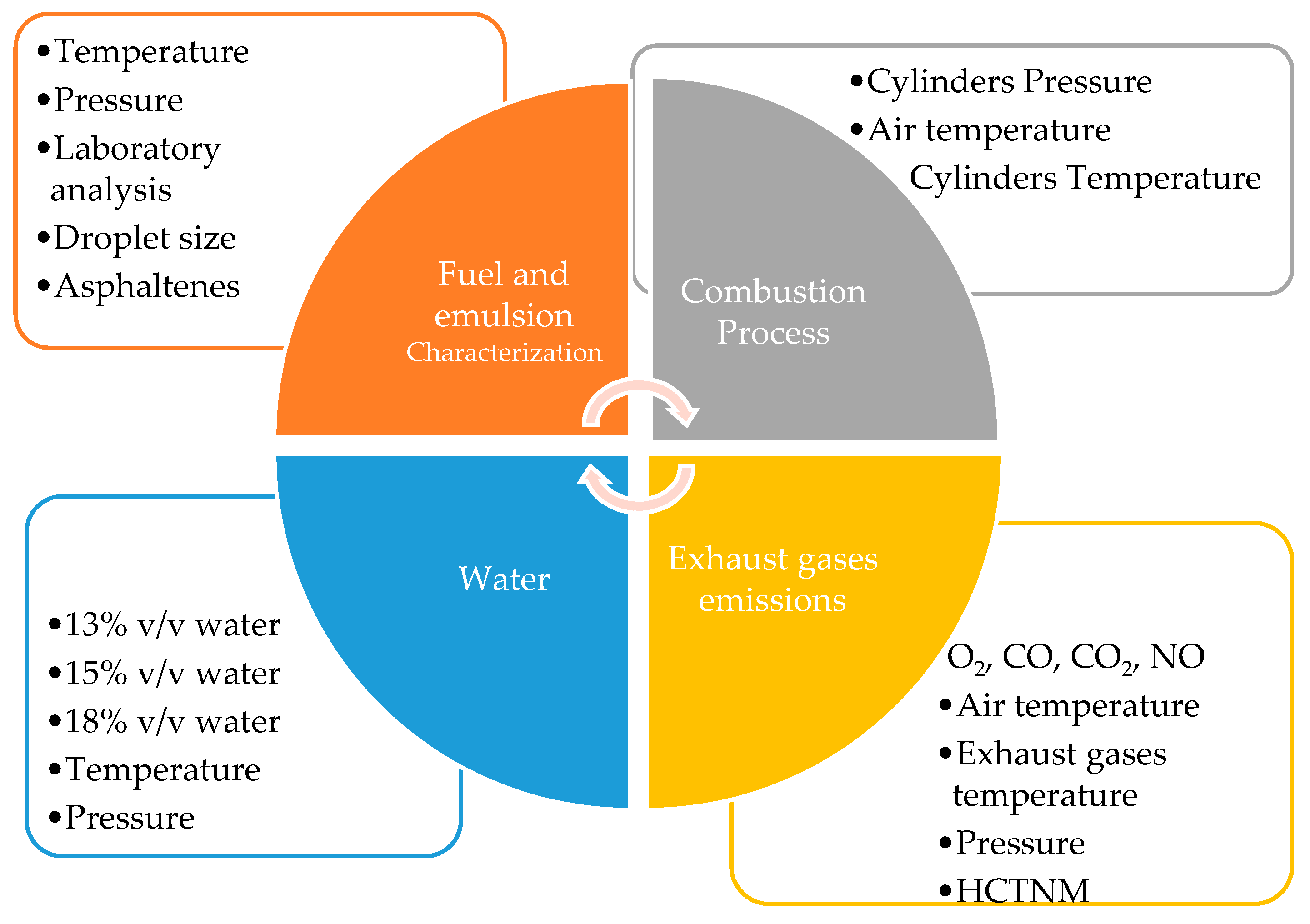


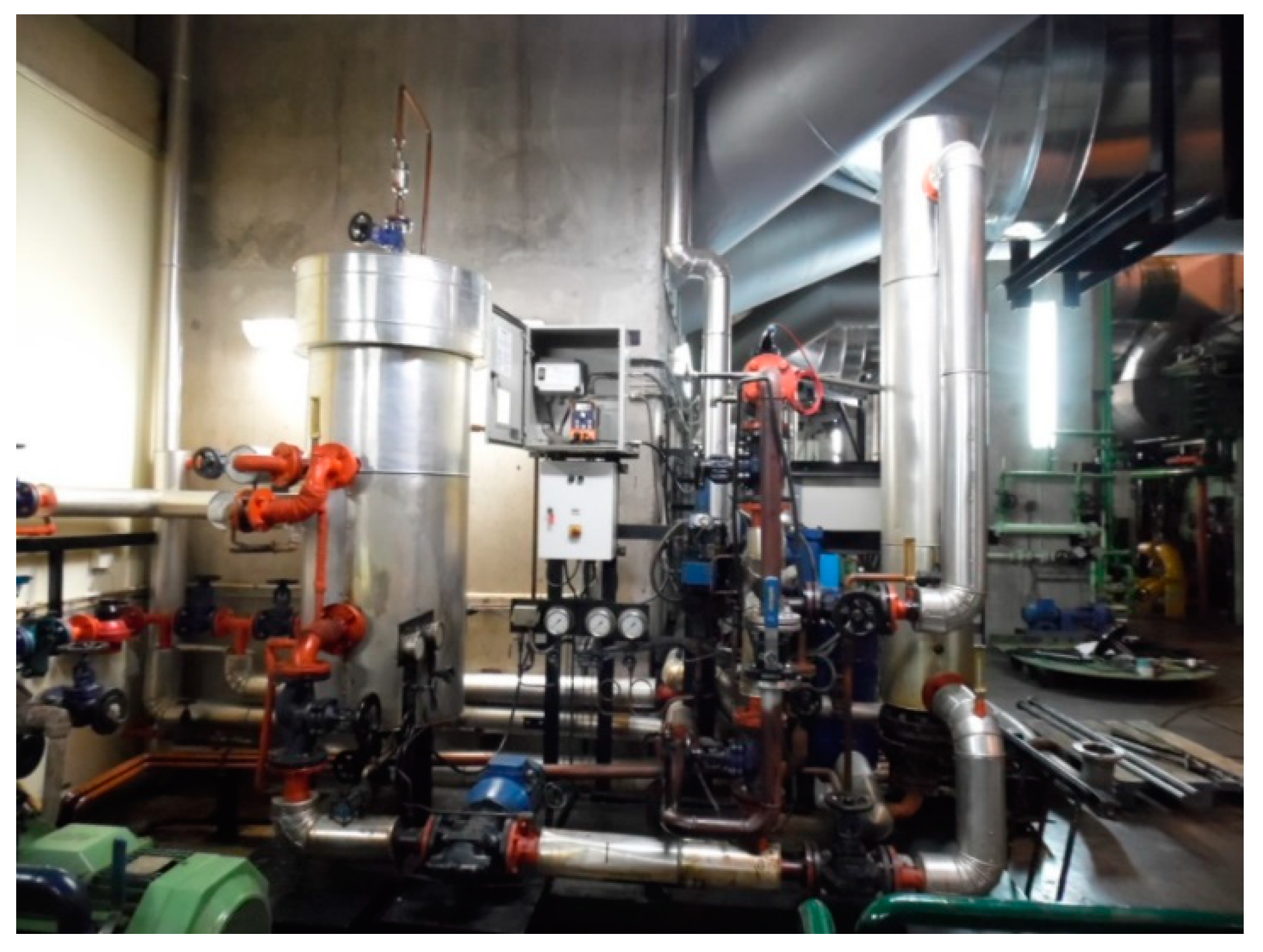
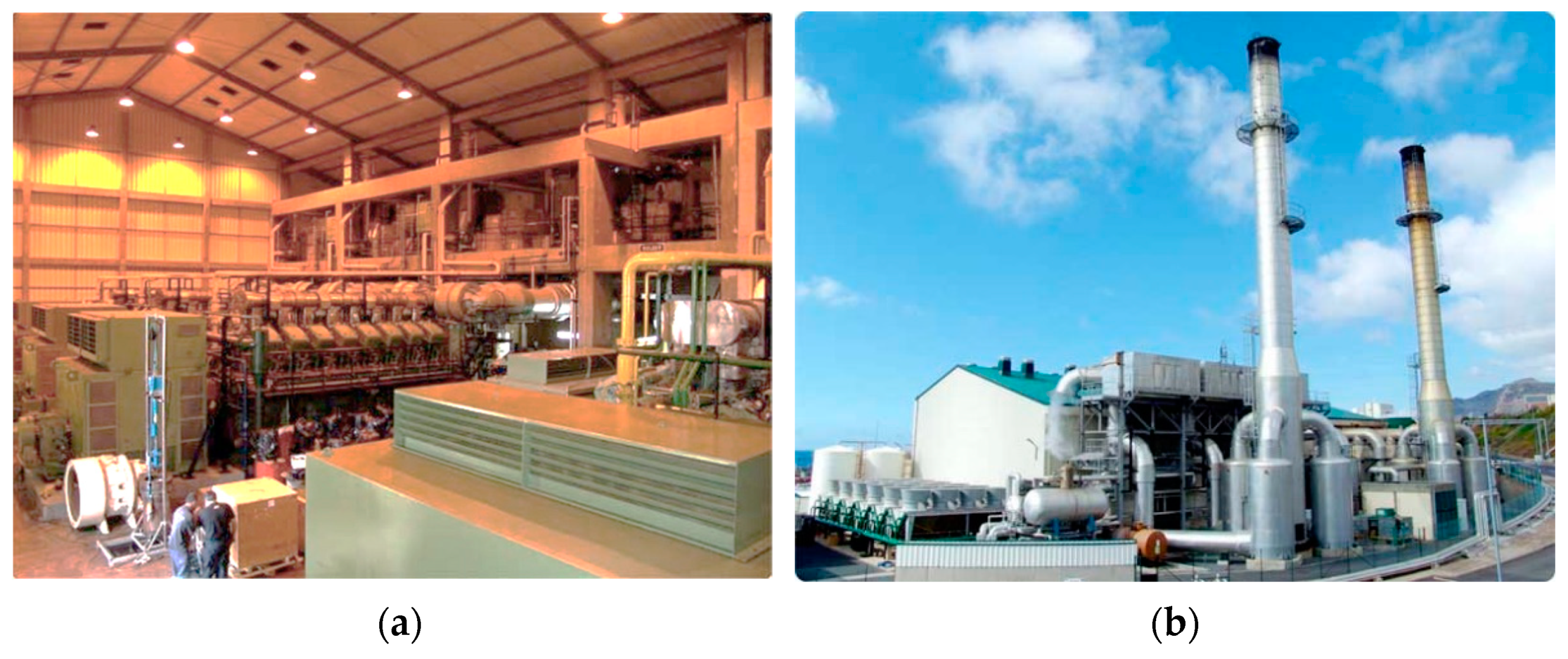
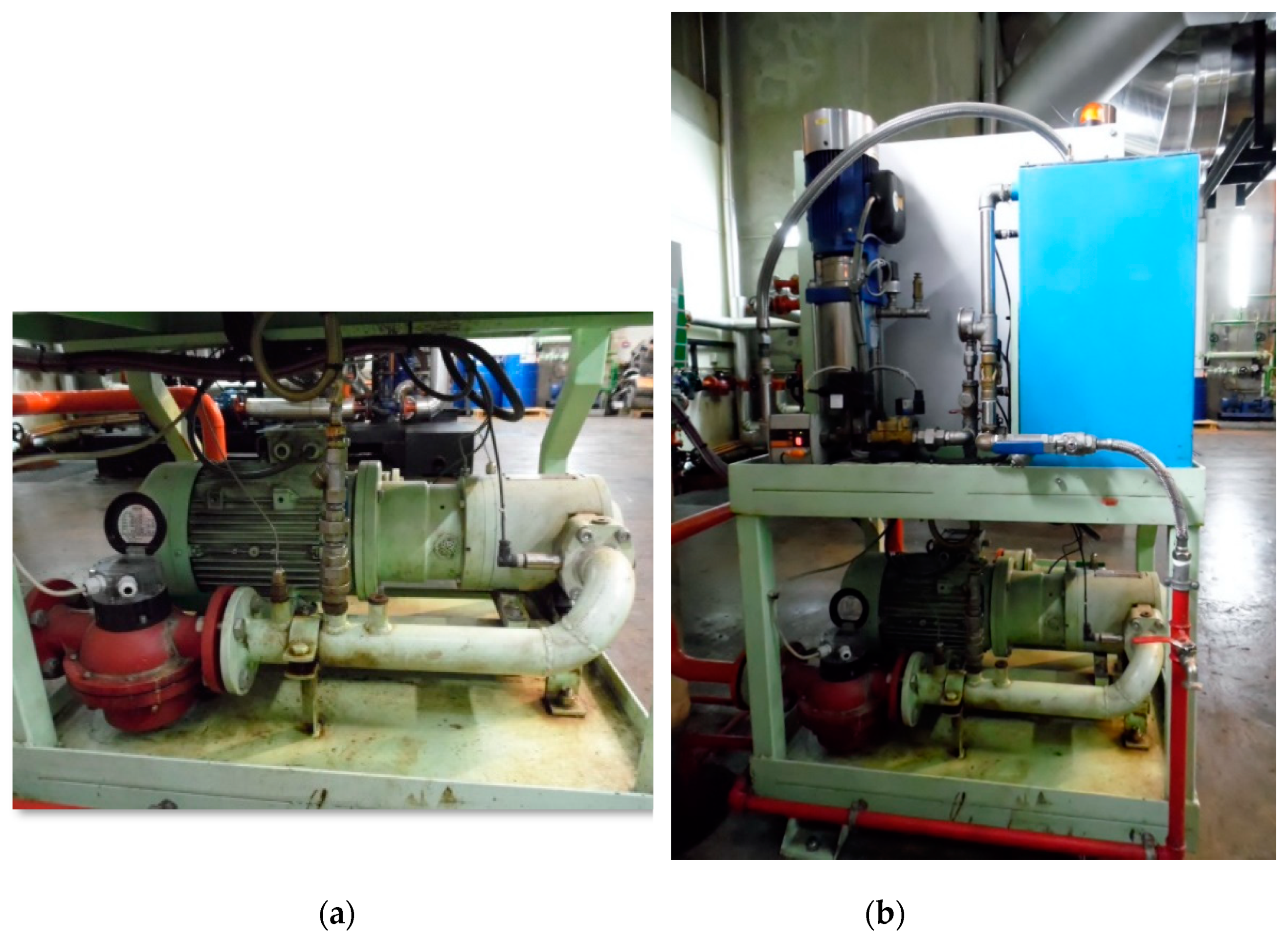

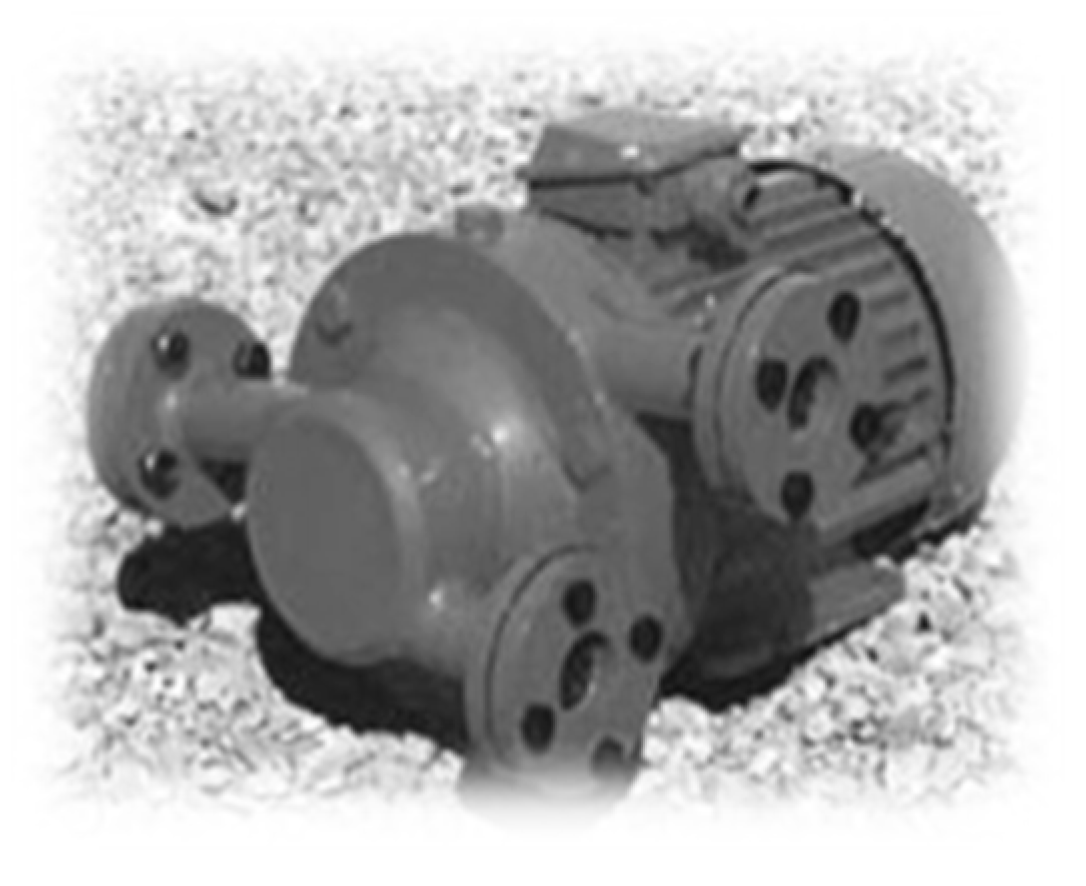

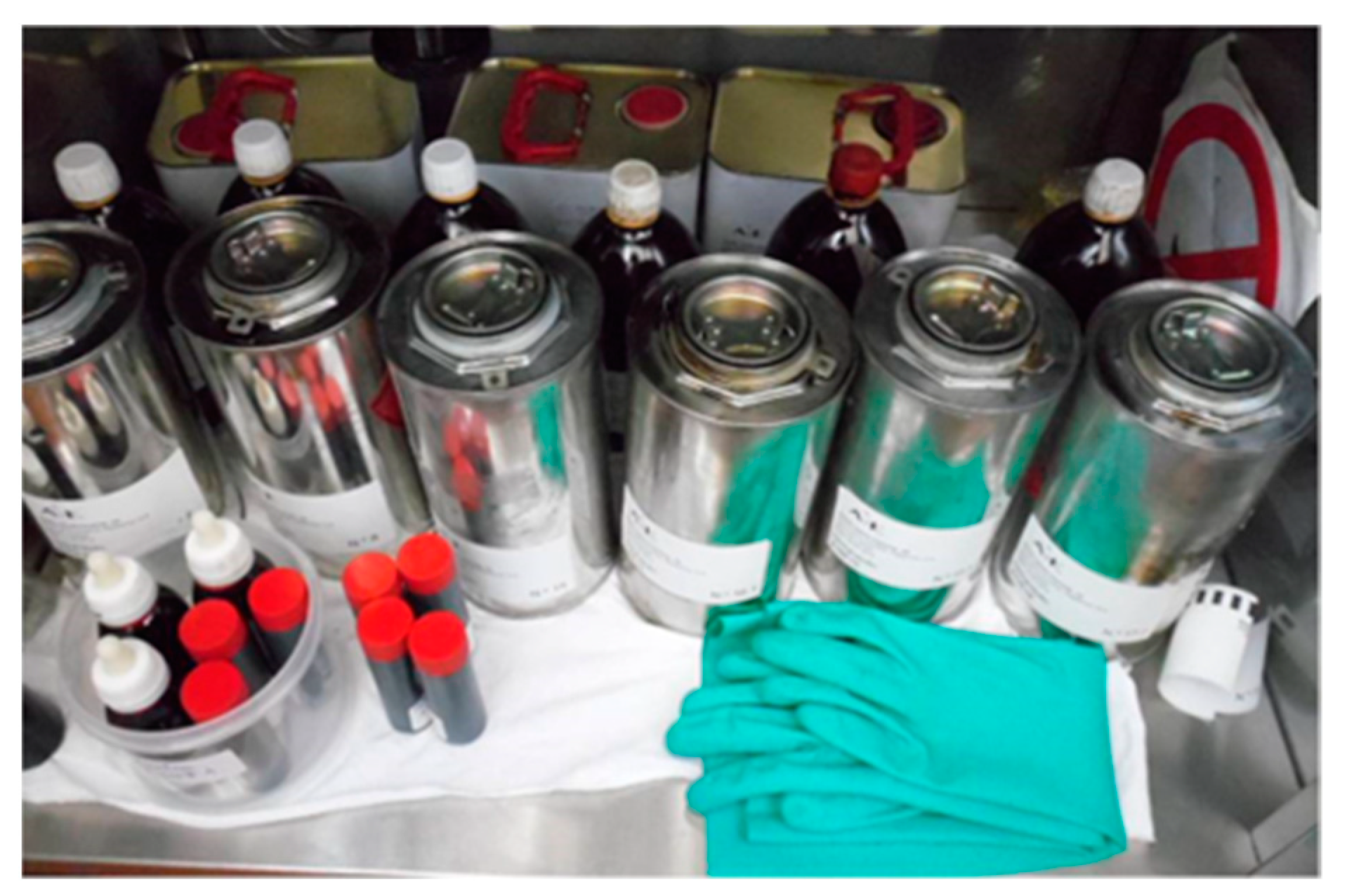
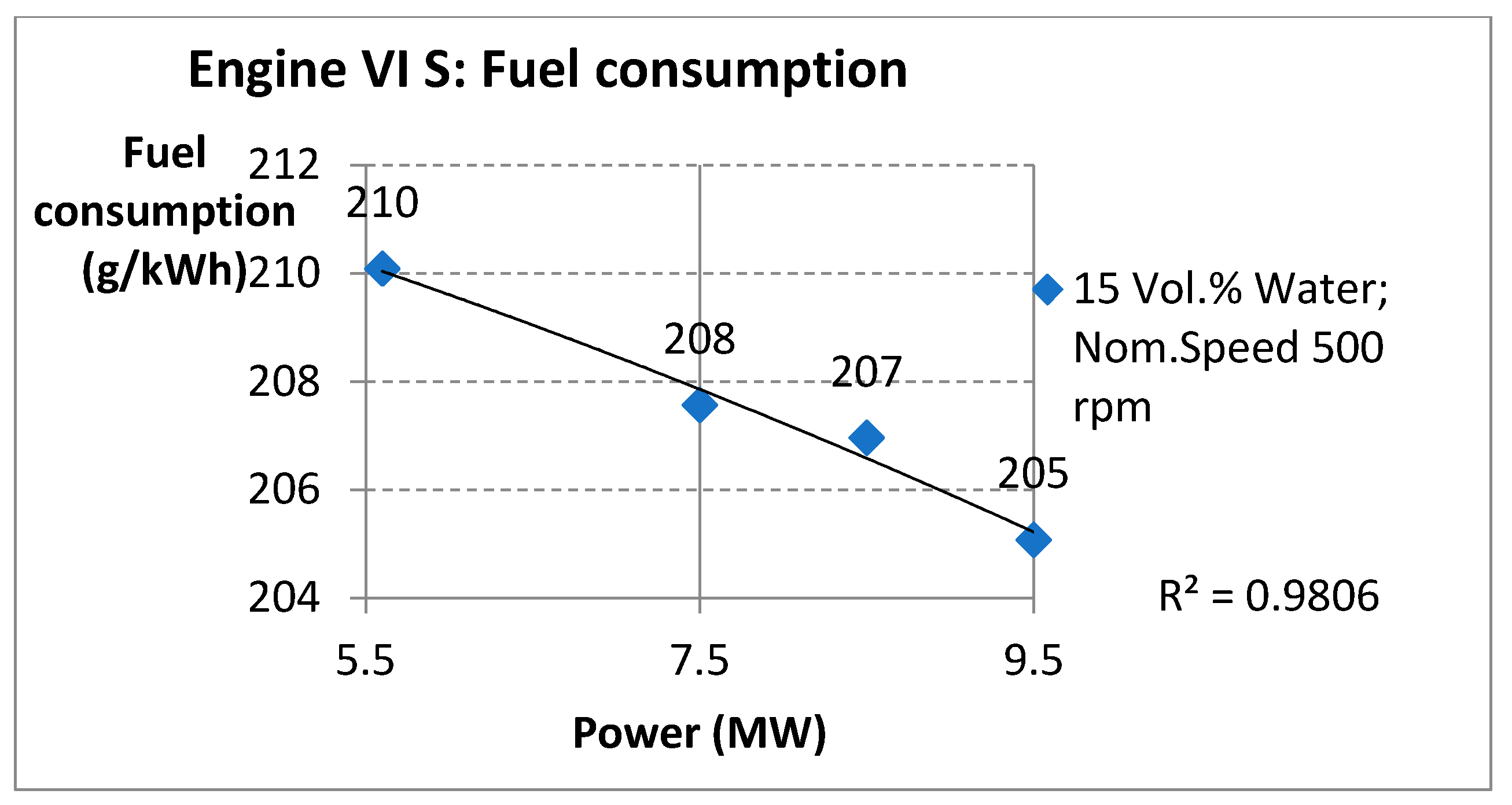



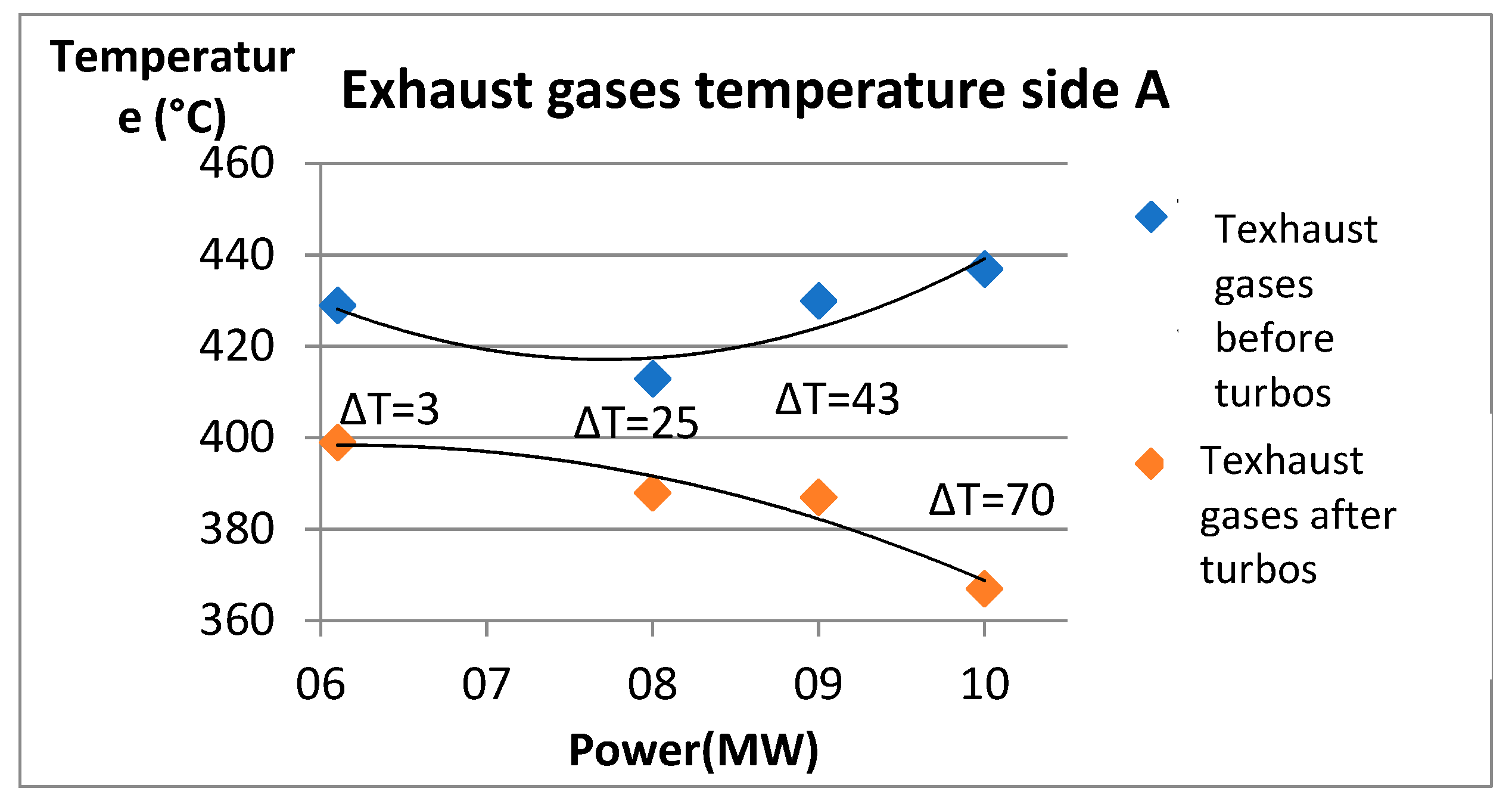
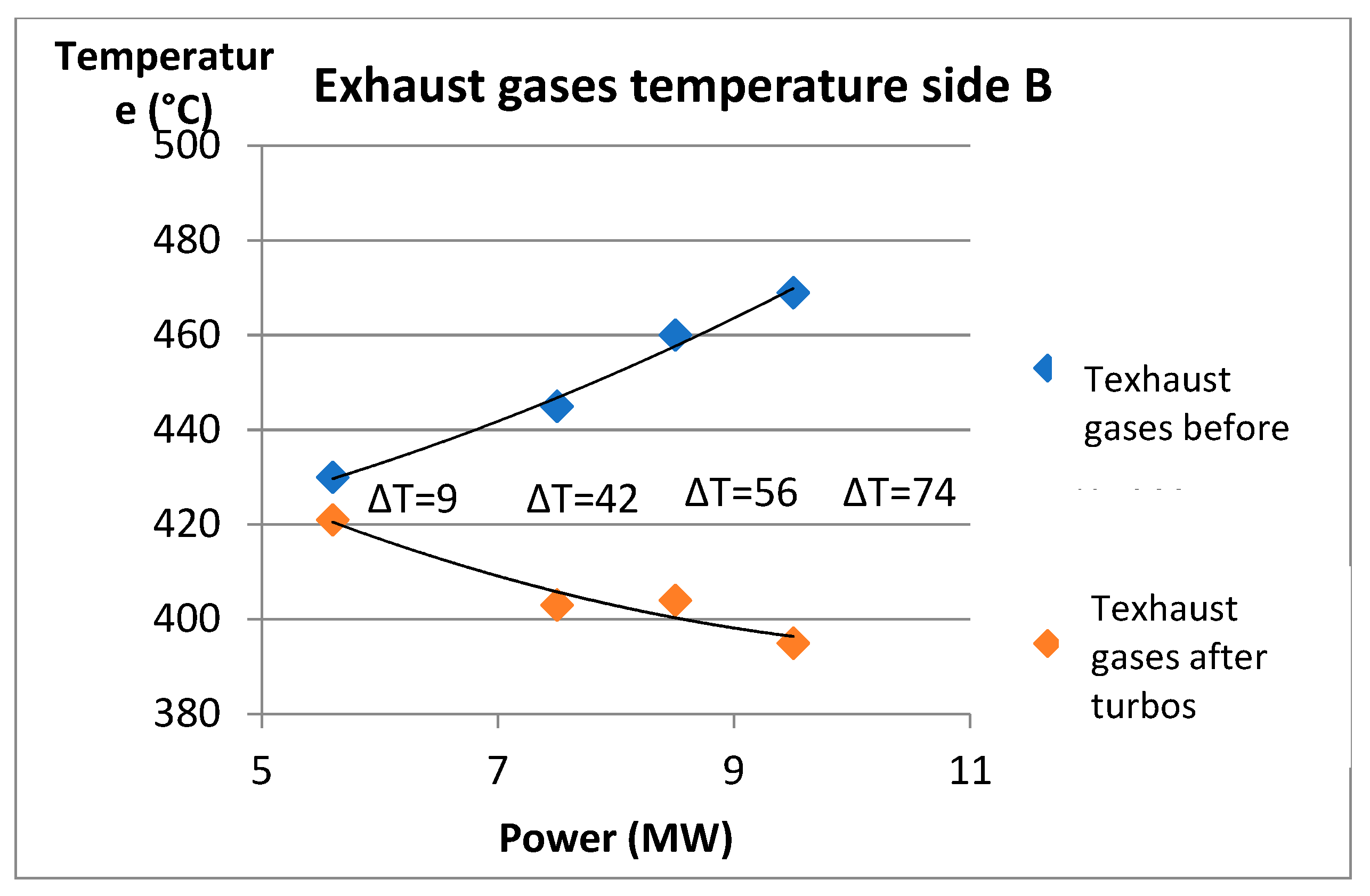




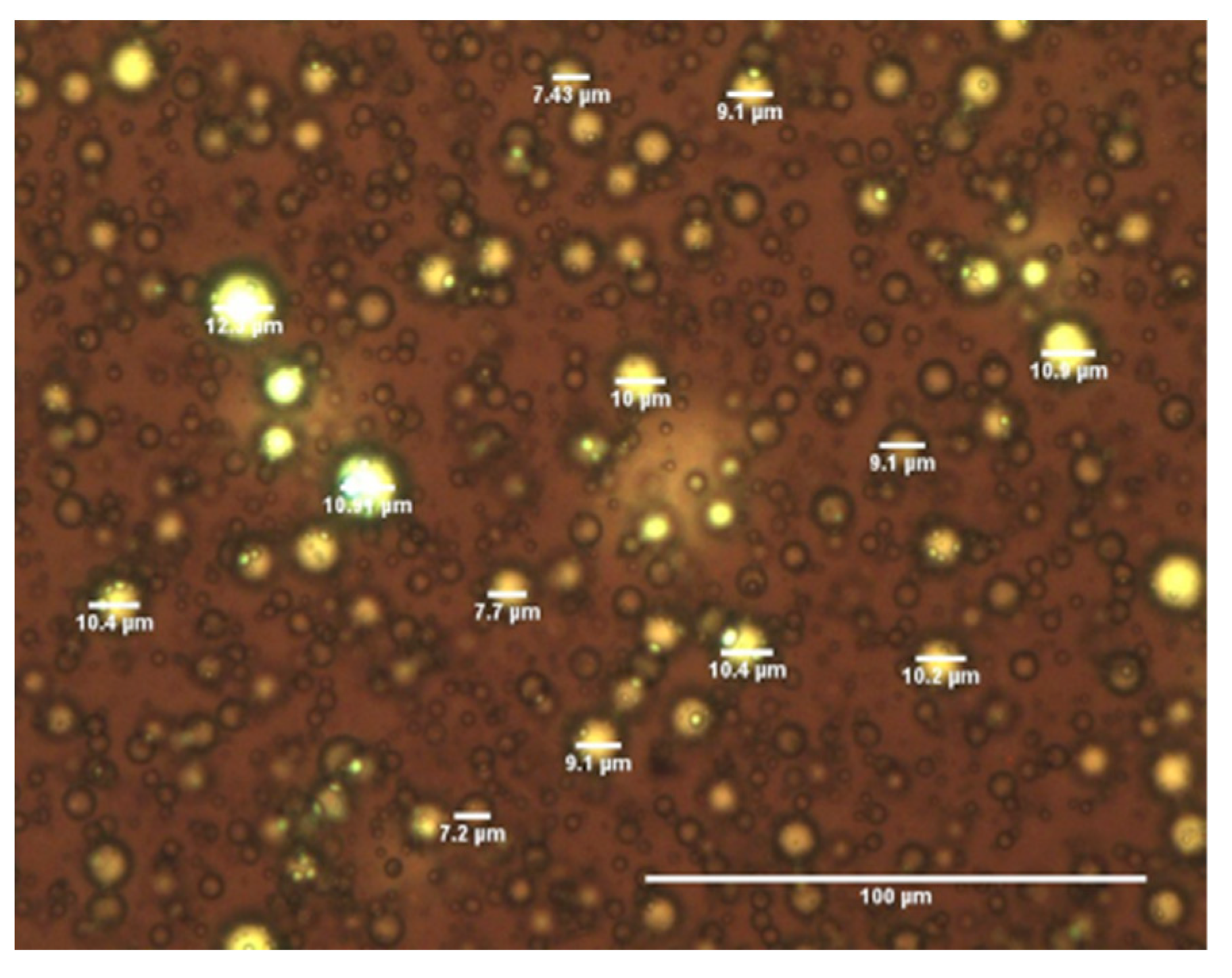


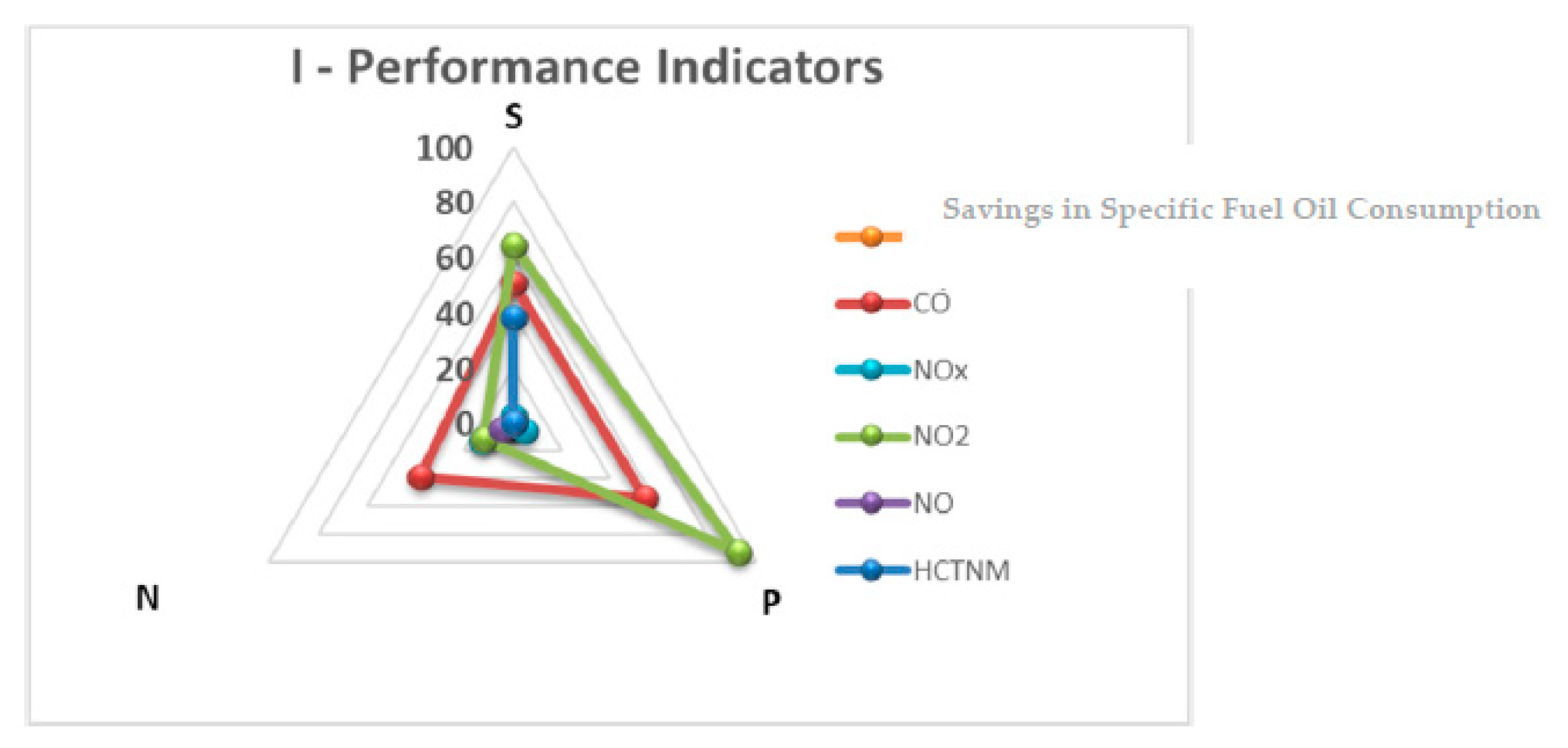
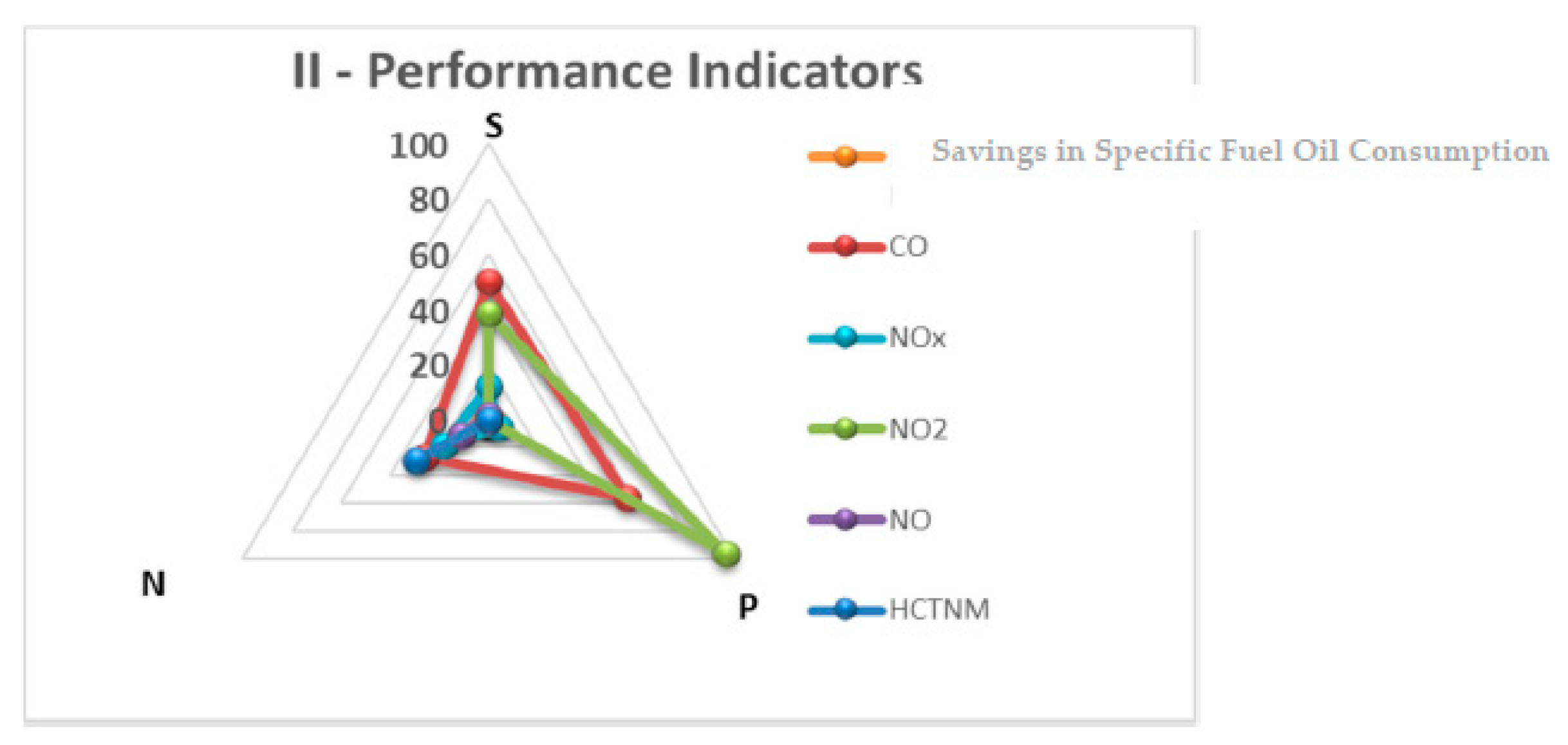
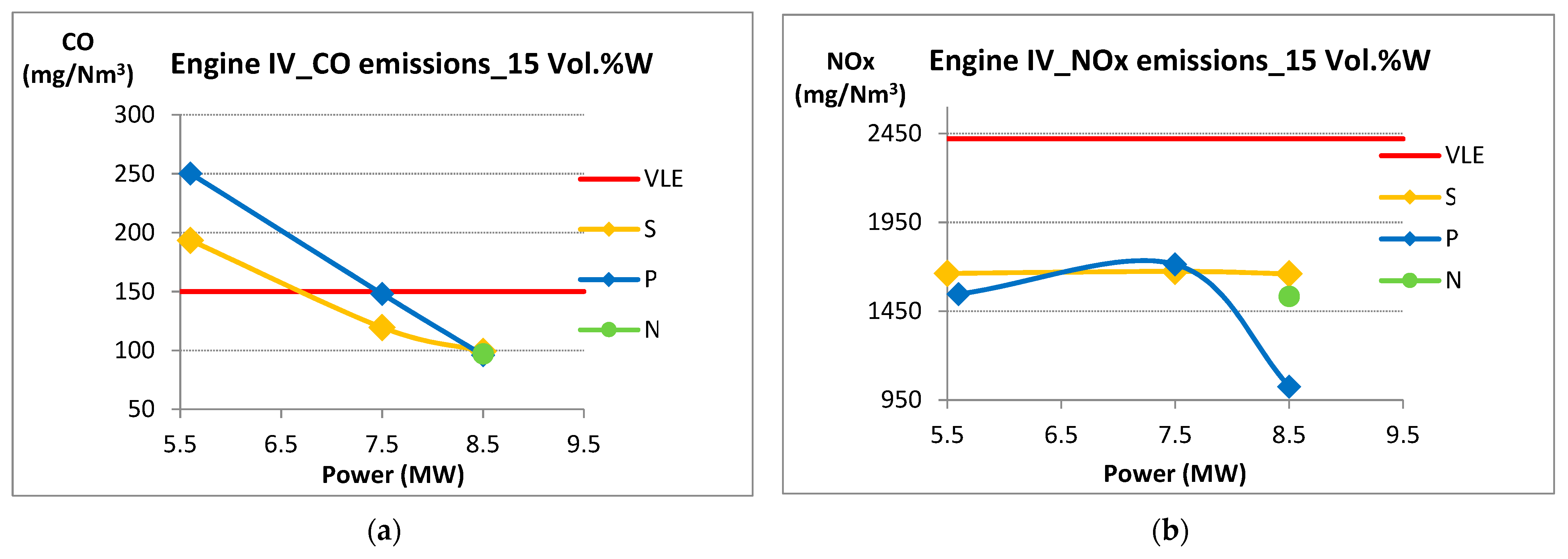
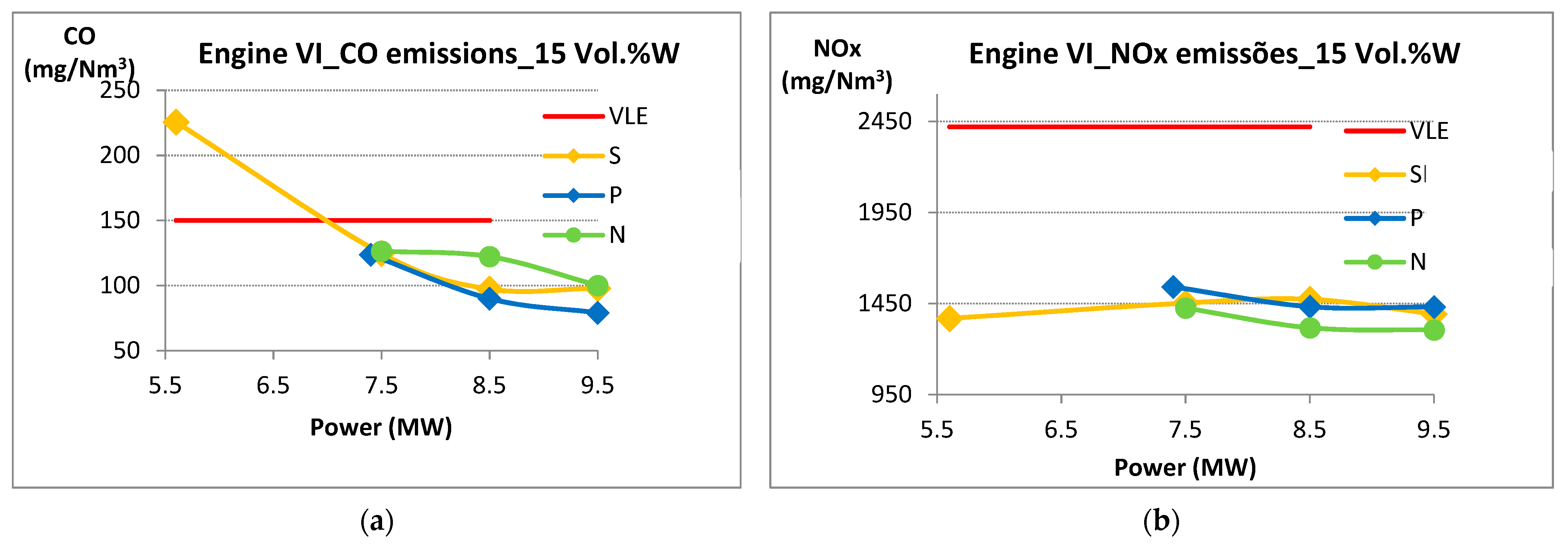


| Parameters | Results | Limits | |
|---|---|---|---|
| Min | Max | ||
| Volumetric mass density at 15 °C (kg/m3) | 981.9 | - | 991 |
| FlashPoint (Proc.B) (°C) | 71.0 | 65 | - |
| Kinematic viscosity 50 °C (mm2/s) | 377.4 | 280 | 380 |
| Sulphur (% m/m) | 0.87 | - | 1.0 |
| Water (% v/v) | <0.05 | - | 0.3 |
| Total Sediment (% m/m) | 0.04 | - | 0.1 |
| Silicon (mg/kg) | 4 | - | 40 |
| Fluxon Point (°C) | −3 | - | 10 |
| Ash (% m/m) | 0.035 | - | 0,1 |
| High Calorific Value (kcal/kg) | 11,169.5 | 9500 | - |
| High Calorific Value (MJ/kg) | 46.76 | 39.77 | - |
| Vanadium (mg/kg) | 39 | - | 100 |
| Sodium (mg/kg) | 45 | 50 | |
| Parameters | Limits | |
|---|---|---|
| Min | Max | |
| pH | 6.5 | - |
| Hardness (mg/L) | - | 10 |
| Drop diameter (µm) | - | 30 |
| Total solids (mg/L) | - | 50 |
| Chlorides (mg/L) | - | 80 |
| Sulfates (mg/L) | - | 150 |
| Specifications CD92-Wide | |
|---|---|
| Project Capacity | <4.5 m3/h |
| Operating Pressure | <12 Bar |
| Operating Temperature | <140 °C |
| Engine Power | 11 kW |
| Rotation Speed | 2895 rpm |
| Water pumping capacity | 1 m3/h |
| Water injection | 20% Max |
| Max Water Pressure | 10 bar |
| System | S | P | N |
|---|---|---|---|
| Diesel Engine | 16ZAV40S | 16ZAV40S | 16ZAV40S |
| Power | 8.5 MW | 8.5 MW | 8.5 MW |
| Rated Speed | 500 rpm | 500 rpm | 500 rpm |
| Fuel | Fuel oil 1%S | Fuel oil 1%S | Fuel oil 1%S |
| Technology | Mechanical Homogenizer Sonic frequencies | Mechanical Homogenizer Cavitator | Mechanical Homogenizer Cavitator |
| Emulsion | 15% Water | 15% Water | 15% Water |
| System | S | P | N |
|---|---|---|---|
| Diesel Engine | 16ZAV40S | 16ZAV40S | 16ZAV40S |
| Power | 8.5 MW | 8.5 MW | 8.5 MW |
| Rated Speed | 500 rpm | 500 rpm | 500 rpm |
| Fuel | Fuel oil 1%S | Fuel oil 1%S | Fuel oil 1%S |
| Technology | Mechanical Homogenizer Sonic frequencies | Mechanical Homogenizer Cavitator | Mechanical Homogenizer Cavitator |
| Emulsion | 18% Water | 18% Water | 18% Water |
| System | Power (MW) | % v/v Water | CO (mg/Nm3) | CO2 (%) | NO (mg/Nm3) | NOX (mg/Nm3) | NO2 (mg/Nm3) |
|---|---|---|---|---|---|---|---|
| S | 8.5 | 15 | 99 | 5.2 | 1002 | 1660 | 123 |
| P | 8.5 | 15 | 96 | 5.3 | 939 | 1025 | 84 |
| N | 8.5 | 15 | 97 | 3.6 | 953 | 1533 | 79 |
| Power (MW) | Fuel Oil Consumption (g/kWh) Reference | % v/v Water | S System (g/kWh) | N System (g/kWh) | P System (g/kWh) |
|---|---|---|---|---|---|
| 7.5 | 210.21 | 7.5 MW 15%W | 207.57 | 207.57 | 207.63 |
| 8.5 | 208.07 | 8.5 MW 15%W | 206.96 | 207.35 | 205.91 |
| 8.5 MW 18%W | 206.45 | 205.26 | 202.44 | ||
| 8.5 MW 18%W Red 12.5% Qair | 208.15 | 204.58 | 206.12 | ||
| 9.5 | 206.53 | 9.5 MW 15%W | 205.08 | 203.93 | 200.91 |
| System | S | P | N |
|---|---|---|---|
| Technology | Mechanical Homogenizer Sonic frequencies | Mechanical Homogenizer Cavitator | Mechanical Homogenizer Cavitator |
| Emulsion | 15% Water | 15% Water | 15% Water |
| Fuel Savings | 0.5 | 1% | 0.3% |
| % Reduction of emissions | S | P | N |
| NOX | 2.7% | 5.4% | 13% |
| NO | 0% | 0% | 4.3% |
| NO2 | 64.2% | 92.8% | 11.9% |
| CO | 50.6% | 54.4% | 38% |
| % HCTNM | 38.3% | 0% | 0% |
| System | S | P | N |
|---|---|---|---|
| Technology | Mechanical Homogenizer Sonic frequencies | Mechanical Homogenizer Cavitator | Mechanical Homogenizer Cavitator |
| Emulsion | 18% Water | 18% Water | 18% Water |
| Fuel Savings | 0.8% | 2.7% | 1.4% |
| % Reduction of emissions | |||
| NOx | 12.5% | 4.2% | 18.5% |
| NO | 1.7% | 0% | 11.3% |
| NO2 | 38.5% | 96.7% | 0% |
| CO | 49.9% | 56.5% | 26.3% |
| % HCTNM | 0% | 0% | 29.5% |
| A11 E0 | S:A19 E15 | N:A22 E15 | P:A9 E15 | P:A12 E18 | N:A13 E18 | |
|---|---|---|---|---|---|---|
| Volumetric mass 15 °C (kg/m3) | 979.9 | 986.3 | 986.6 | 982.1 | 983.4 | 986.9 |
| Kinematic viscosity 50 °C (cSt) [60] | 375.6 | 511.9 | 474.2 | 452.7 | 499.1 | >553.7 (584.9) |
| Flash Point PM-Proc.B (°C) | 73.5 | 99 | 93 | 99 | 106 | 100 |
| Water content (%v/v) | <0.10 | 15 | 15 | 15 | 18 | 18 |
| Total sediment (%m/m) | 0.02 | - | - | - | - | - |
| Ash (%m/m) | 0.031 | - | - | - | - | - |
| Asphaltenes(%m/m) | 10.1 | 7.9 | 6.4 | 9.4 | 8.9 | 6.6 |
| Vanadium (mg/kg) | 35 | - | - | - | - | - |
| Sodium (mg/kg) | 31 | - | - | - | - | - |
| Silicon (mg/kg) | 6 | - | - | - | - | - |
| Flux point (°C) | −6 | - | - | - | - | - |
| Lower Calorific Value (MJ/kg) | 40.8 | 35.94 | 35.95 | 37.33 | 36.01 | 34.69 |
| CCAI (ignition quality index) | 841.5 | 843.49 | 843.79 | 841.8 | 842.1 | 844.1 |
| Sulphur (%m/m) | 0.86 | 0.85 | 0.82 | 0.75 | 0.75 | 0.64 |
| Fuel Oil LHV (MJ/kg) | Emulsion S LHV (MJ/kg) | Emulsion P LHV (MJ/kg) | Emulsion N LHV (MJ/kg) |
|---|---|---|---|
| 40.8 | 35.94 | 37.11 | 35.95 |
Publisher’s Note: MDPI stays neutral with regard to jurisdictional claims in published maps and institutional affiliations. |
© 2022 by the authors. Licensee MDPI, Basel, Switzerland. This article is an open access article distributed under the terms and conditions of the Creative Commons Attribution (CC BY) license (https://creativecommons.org/licenses/by/4.0/).
Share and Cite
Pereira, F.; Silva, C. Combustion of Emulsions in Internal Combustion Engines and Reduction of Pollutant Emissions in Isolated Electricity Systems. Energies 2022, 15, 8053. https://doi.org/10.3390/en15218053
Pereira F, Silva C. Combustion of Emulsions in Internal Combustion Engines and Reduction of Pollutant Emissions in Isolated Electricity Systems. Energies. 2022; 15(21):8053. https://doi.org/10.3390/en15218053
Chicago/Turabian StylePereira, Fabíola, and Carlos Silva. 2022. "Combustion of Emulsions in Internal Combustion Engines and Reduction of Pollutant Emissions in Isolated Electricity Systems" Energies 15, no. 21: 8053. https://doi.org/10.3390/en15218053
APA StylePereira, F., & Silva, C. (2022). Combustion of Emulsions in Internal Combustion Engines and Reduction of Pollutant Emissions in Isolated Electricity Systems. Energies, 15(21), 8053. https://doi.org/10.3390/en15218053






